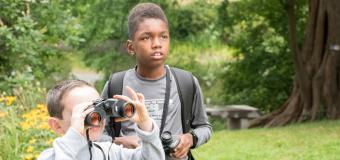Making Connections with Nature and the Environment
In the decade since Richard Louv's book Last Child in the Woods took the country by storm, educators, parents, health providers, conservationists, and administrators have been rethinking the nature/child relationship. Research is showing us the powerful positive impact on the health and well-being of children when they are connected to their environments. Environmental educators in particular have been instrumental in creating awareness, programs, and opportunities for children of all ages to connect with the natural world, knowing that our future depends on ecologically literate citizens who will have a sense of ownership and stewardship of the earth. A No Child Left Inside movement has been spawned as a result.
Of primary importance in these efforts is making sure children are engaged in the natural world. Here are 7 favorite ways from Lesley science faculty:
1. Allow children unfettered time in the natural world.
This means not organized sports or adult-directed activities, but lengthy time to explore, play, and invent. It might take the form of building a fort from found objects, damming a stream, or collecting natural objects like shells, rocks, or acorns. These moments in nature are recalled later, as adults, in vivid description.
2. Be a Mentor
Rachel Carson, in her 1956 article entitled “A Sense of Wonder,” implored adults to find one child to mentor in the workings of the natural world. Whether parent, grandparent, or other relative or friend, most adult conservationists can point to those people in their lives who had significant influence on them.
3. Create opportunities for children to have experiences with the more-than-human world.
Volunteering at a wildlife rehabilitation center, snorkeling on a vacation, or simply walking in nature and having surprise contact with local species are all important ways children can come in contact with the species that share their home. Speak of them as friends and talk about how they are connected to humans.
4. Study the local bioregion.
Guide children to understand the area they live in: for instance, where their water comes from and where it goes once it leaves their home or school; what plants are native or non-native, wild or cultivated; what animals share their home with them; how people make a living from the earth’s resources; and what natural wonders—ponds or streams, marshes, hills, and so on—are nearby.
5. Engage children in real life actions.
Whether it is planting trees, creating a garden, pulling invasive species, or picking up garbage—begin the stewardship mindset.
6. Enroll your child in a real outdoors camping program.
In addition to a physical fitness camp, technology camp, or sports camp, find a camp where children sing by the campfire, sleep out under stars, learn to make bows and arrows, learn to steer a canoe, or learn to use a bow drill to make a fire.
7. Get to know your state or national parks. If you are lucky enough to live near a protected area, visit. These parks are protected for a reason and offer wonderful opportunities for hiking and exploring and experiencing the sounds, smells, and excitements of unfamiliar natural environments. Find a state park. Find a national park.
